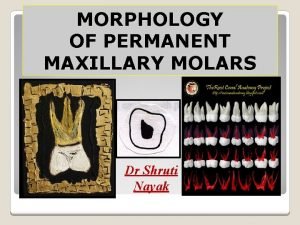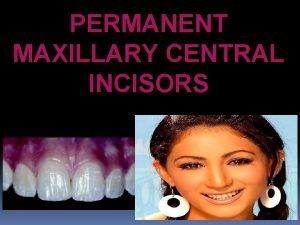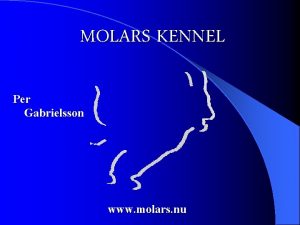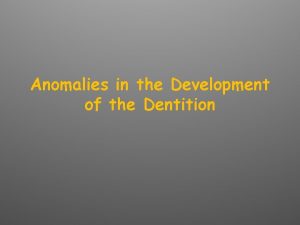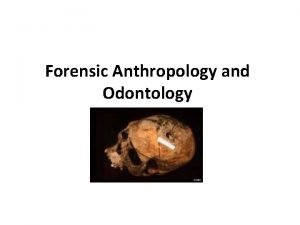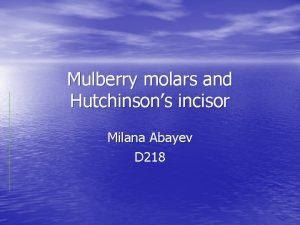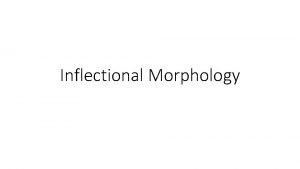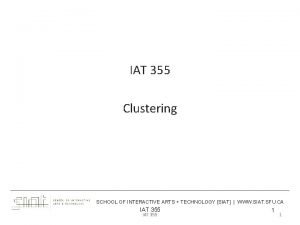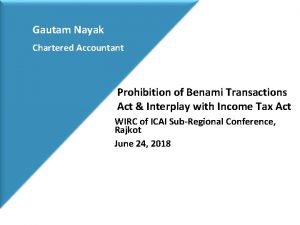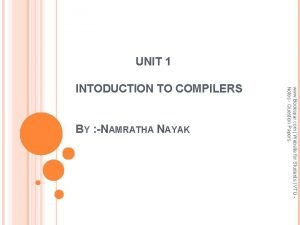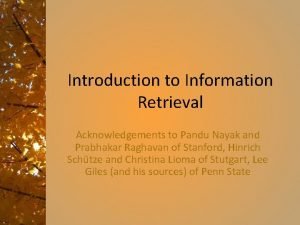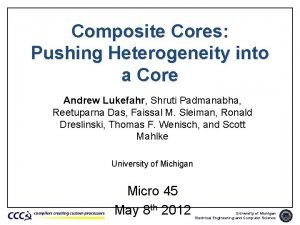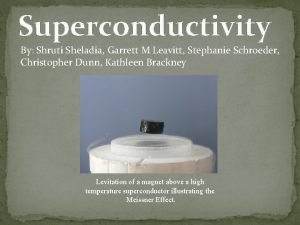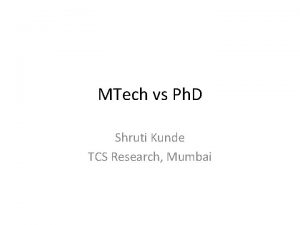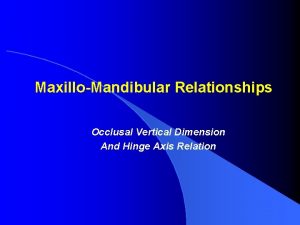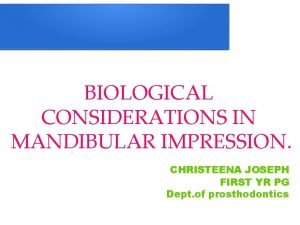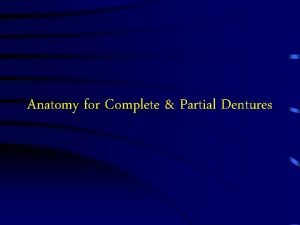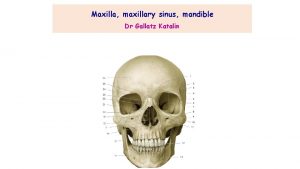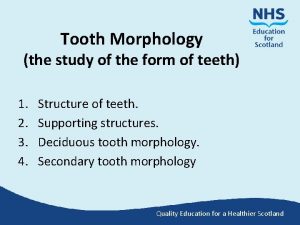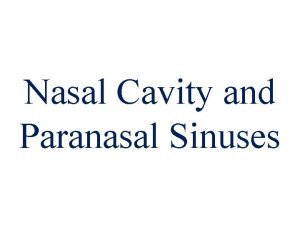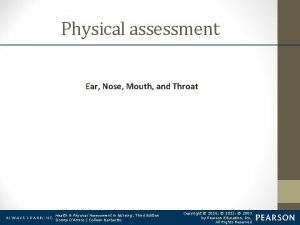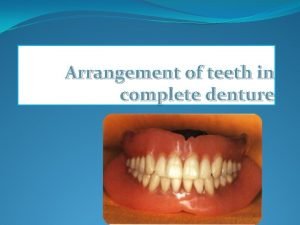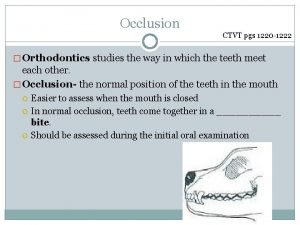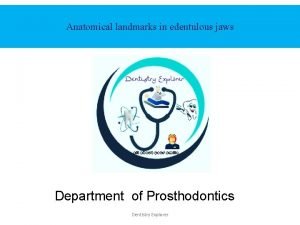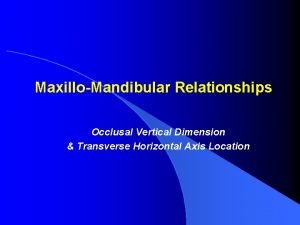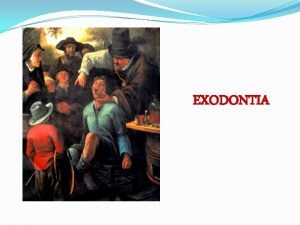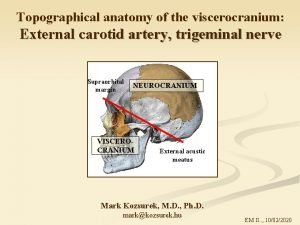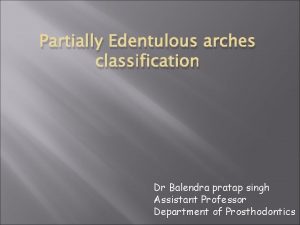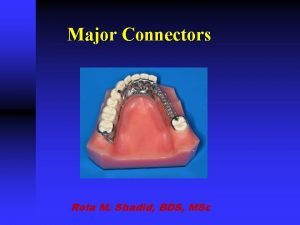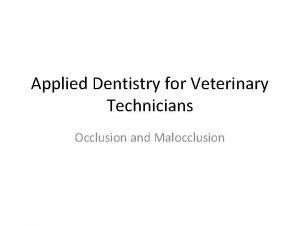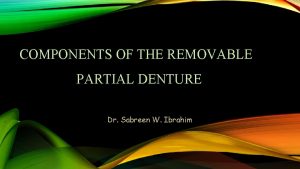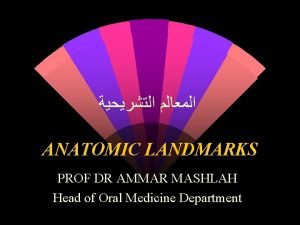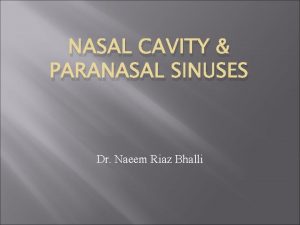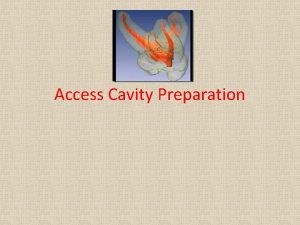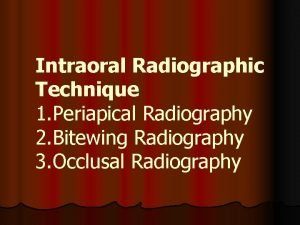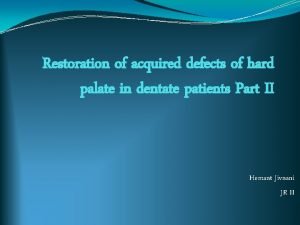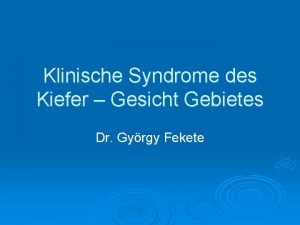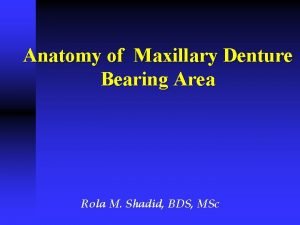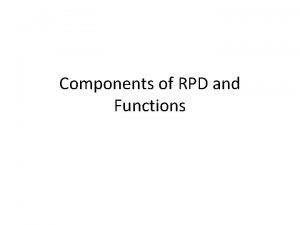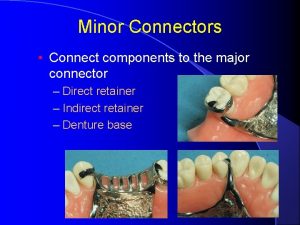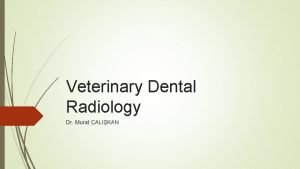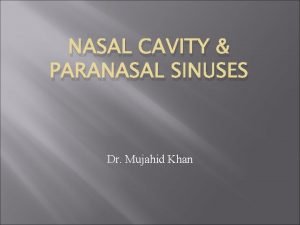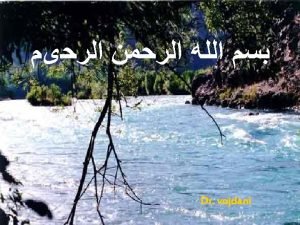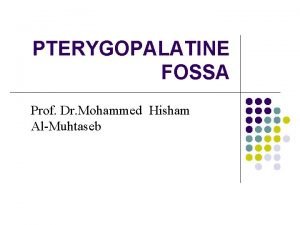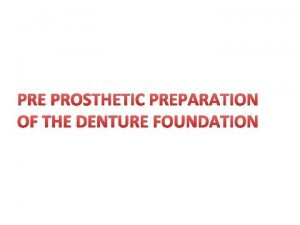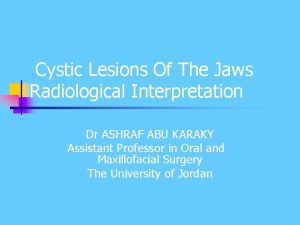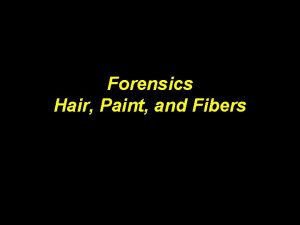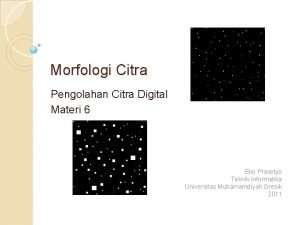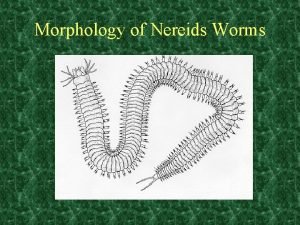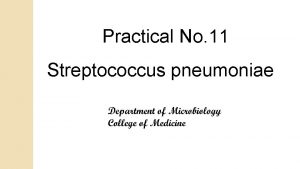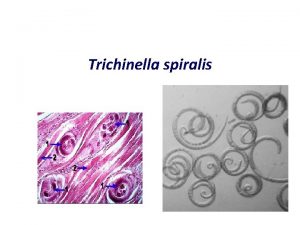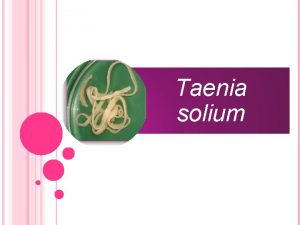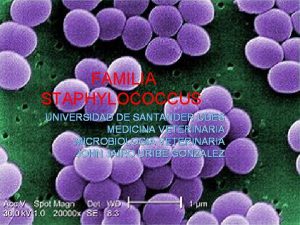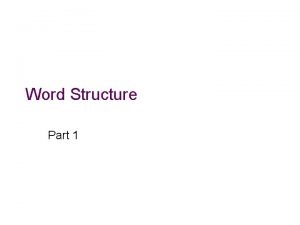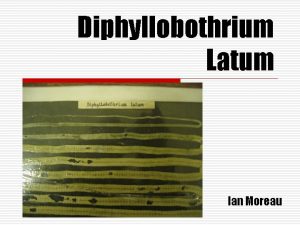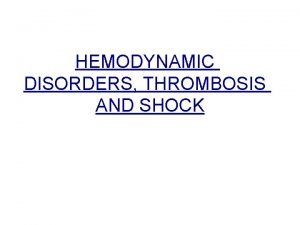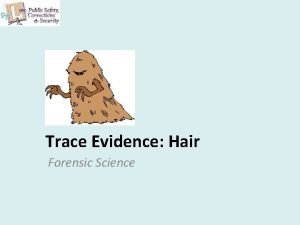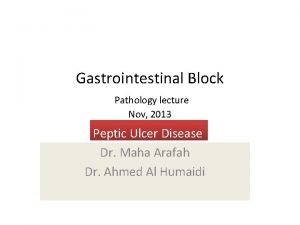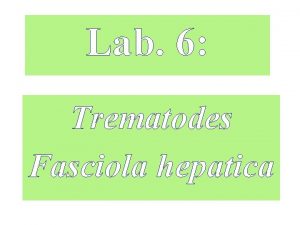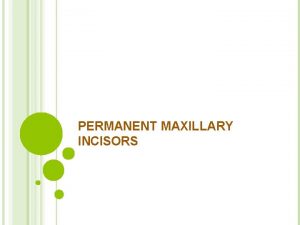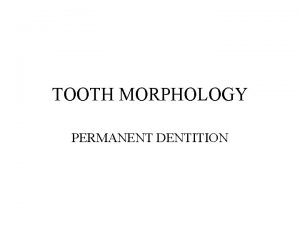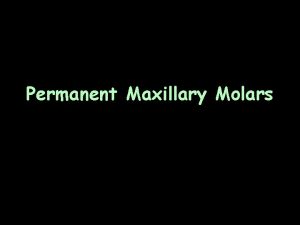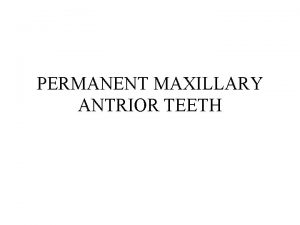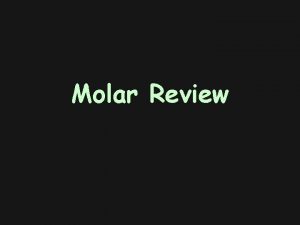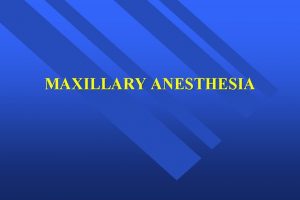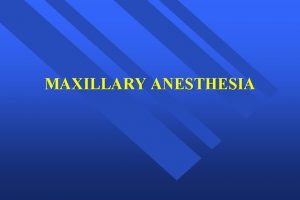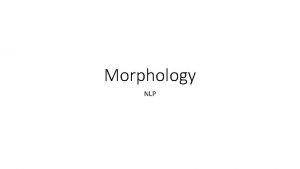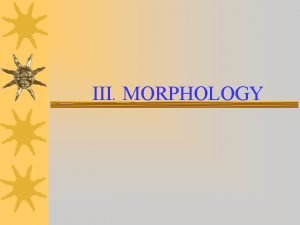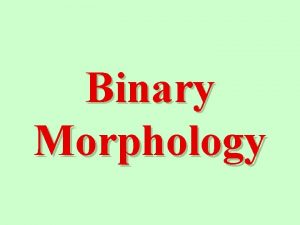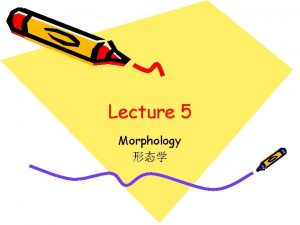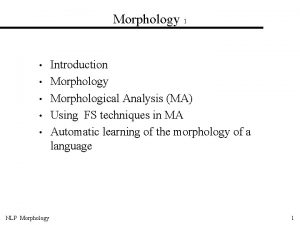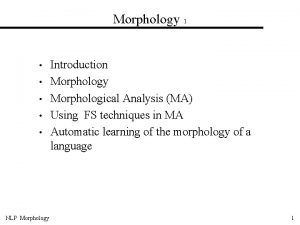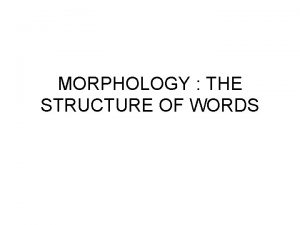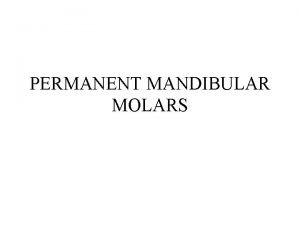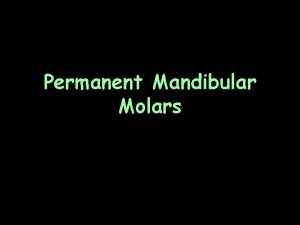MORPHOLOGY OF PERMANENT MAXILLARY MOLARS Dr Shruti Nayak















































































- Slides: 79

MORPHOLOGY OF PERMANENT MAXILLARY MOLARS Dr Shruti Nayak

INTRODUCTION There are three permanent maxillary molars. 1 st, 2 nd, and 3 rd. FUNCTIONS: Molar teeth have a major role in Ø Mastication of food Ø Support to the cheeks and also Ø Maintaining vertical dimension of face and fullness of cheek.

General characteristics of Permanent Maxillary Molars Maxillary molars are larger than other larger maxillary teeth Crown is bucco-lingually larger in contrast to the corresponding teeth on the mandibular arch with are larger mesiodistally.

Crown is centered over the root and has 3 primary cusps and a fourth relatively smaller cusp that is disto-lingual cusp. All maxillary molars have an oblique ridge extending from the most prominent mesio-lingual cusp to the disto-buccal cusp. They have three roots, two buccal and one lingual. All the roots converge to a root base called root trunk

Maxillary permanent molars Arch traits ◦ 3 roots: 2 B & 1 L MB DB ◦ Crown: BL > MD ◦ Cusps ML DL 3 major cusps ◦ ML, MB & DB Lesser-sized DL cusp ◦ Oblique ridge: ML to DB cusp ◦ Buccal and lingual cusps are of unequal size ◦ ML cusp is larger than DL

MAXILLARY MANDIBULAR

Permanent Molars Class traits ◦ 3 or more cusps ◦ At least 2 buccal cusps ◦ One or more lingual cusps ◦ In general 2 or 3 roots

Maxillary permanent molars Type trait (in general) ◦ DL cusp reduces in size when going posteriorly & may be missing in 3 rd molar ◦ 1 st molar is the largest & shows the least morphological variation ◦ Cusp of Carabelli

Maxillary permanent 1 st molar Buccal aspect ◦ MB & DB cusps are of equal height ◦ MB is wider ◦ Separated by B groove ◦ Slopes of DB are steeper ◦ Tip of the ML cusp between B cusps DB MB

BUCCAL ASPECT CROWN Shape D M is trapezoidal with broader of the unequal part being occlusal and narrower the cervical outline. Mesial out line- is nearly straight which becomes convex at mesial contact area located at the junction of occlusal and middle 1/3 rd. The out line continues to join to the mesial cusp slope of mesio-buccal cusp.

DISTAL CONTACT AREA • 2 • 1 MESIAL CONTACT AREA

BUCCAL ASPECT Distal DB MB outline is convex with contact area in the middle of middle 1/3 rd Occlusal outline is represented by buccal cusps and cusp slopes. From buccal aspect two cusps are seen; a mesio-buccal and disto-buccal cusps. Mesio-buccal cusp is wider and slightly longer than the disto-buccal cusps. Cervical outline is irregular and shows slight curvature to the root.

BUCCAL ASPECT BUCCAL SURFACE Buccal groove is seen separating two buccal cusps, extending to middle 1/3 rd with a pit DB MB Roots From the buccal aspect a distinct root trunk (undivided part of the root) is visible. Root trunk bifurcate giving rise to two buccal roots a mesio-buccal and a disto-buccal root. Both the roots are well separated, taper apically and often are curved distally.

PALATAL ASPECT Crown – Crown of maxillary first Crown molar is broader mesio-distally ML DL on the lingual side than on the buccal side Two well developed cusps are visible from this aspect, the larger mesio-lingual cusp and smaller disto-lingual cusp Mesio-lingual cusp is the longest and largest cusp of this tooth and the cusp slopes meet at 90 degrees. The disto-lingual cusp is smallest and is more rounded

PALATAL ASPECT 5 TH M. L D. L

PALATAL ASPECT The lingual cusps are 5 TH CUSP separated by a lingual developmental groove that extends from occlusal aspect to the lingual surface Frequently a fifth cusp is found on the lingual surface of mesio-lingual cusp, located 2 mms cervical to the tip of the mesio-lingual cusp. This cusp is separated from mesio-lingual cusp by a fifth cusp groove The cusp is named as ‘cusp of Carabelli’ Carabelli after the person first described it.

PALATAL ASPECT The presence or absence of ‘cusp of Carabelli’ is a racial Carabelli characteristic and when present may show variation in size & shape Roots: Only one root is present on Roots DL ML lingual side which is the longest of all 3 roots The lingual root tapers to a blunt apex. From the lingual aspect along with the lingual root both mesio buccal and disto buccal roots are also visible.

MESIAL ASPECT Crown Shape B L appears to the short and broad facio-lingually. Buccal outline is convex at cervical 1/3 rd, followed by slight concavity and again convex as it progresses further to end at cusp tip. Crest of buccal outline is usually located immediately below the cervical line.

MESIAL ASPECT Lingual outline is some what similar to buccal outline, but crest of the lingual outline is often found at the middle 1/3 rd Cervical outline is irregular and curved towards the crown Mesial B L surface is generally convex. A shallow concavity may be seen cervical to the contact area which may continue on to the root surface

crest B L

MESIAL ASPECT Occlusal outline – is represented by cusps and marginal ridge. Two cusps are seen; a mesio-buccal cusp and a larger, longer mesio-lingual cusp. Fifth cusp, the cusp of Carabelli is found on the lingual surface of mesio-lingual cusp. Distinct mesial marginal ridge is present which is irregular and curved Mesial marginal ridge is placed at an occlusal level than that of distal marginal ridge.

Root – Tow roots are visible from this aspect, mesio-buccal root and the lingual root. The level of bifurcation on the mesial aspect is closer to(less MB than 4 mm) the cervical line. The lingual root is 1. 5 mm longer than MB root but narrower in a bucco-lingual direction. The roots are well separated and the boundaries of the roots may extend beyond the crown. This feature helps to differentiate this tooth from that of 2 nd molar. Ling

DISTAL ASPECT Crown – Tooth shows a convergence Crown distally making the buccal and lingual aspects visible Mainly two cusps, disto-buccal and DL DB disto-lingual Parts of other cusps including the ‘cusp of Carabelli’ can be seen. Of the two cusps disto-buccal cusp is slightly larger than disto-lingual cusp.

DISTAL ASPECT The distal marginal ridge is shorter, more concave and cervically placed than mesial marginal ridge making a part of occlusal aspect visible from distal aspect. Cervical time is less curved on distal aspect. Distal surface is generally convex except for a shallow concavity at cervical region which may continue on to the root surface up to the level of bifurcation.

DISTAL ASPECT

DISTAL ASPECT Roots: All the three roots are seen from this aspect. The mesio-buccal root is mesio-buccal seen because the distobuccal root is shorter and buccal narrow. Lingual root seen Level of bifurcation on the distal side is more apical than on mesial side. MB Ling DB

OCCLUSAL ASPECT Occlusal outline is rhomboidal / parallelogram in shape. It has two acute angels and two obtuse Acute angels are mesio-buccal and distolingual and obtuse angles are mesiolingual and disto-buccal. O A A O

OCCLUSAL ASPECT Tooth is wider bucco-lingually (1 mm) than mesio-distally. Crown shows a buccal and a distal convergence. The lingual half of the tooth is wider mesio- distally than buccal half. Similarly the mesial half of the tooth is bucco-lingually wider than distal half.

OCCLUSAL ASPECT Cusps - Four major cusps are seen; i. e. mesio-lingual cusp which is longest and largest followed by mesio-buccal, distobuccal and disto-lingual cusp Of this four cusps mesio-lingual, mesiobuccal and disto-buccal forms the primary cusps of first molar. A fifth cusp the ‘cusp of Carabelli’ is also seen lingual to mesio-lingual cusp which is located 2 mm cervical to the tip of the mesiolingual cusp

OCCLUSAL ASPECT ◦ Square or rhomboidal ◦ MB & DL angles are acute ◦ ML & DB angles are obtuse ◦ 1/3 of B surface & ½ of L are visible ◦ B outline: D part is more L than M part DB DL MB ML



Occlusal table ◦ Cusps in order of decreasing size: ML, MB, DB & DL ◦ M MR is longer & more prominent than D MR ◦ Oblique ridge ◦ Major Fossae Central fossa ◦ Central pit Distal fossa ◦ D pit ◦ DL groove which continues as the L groove


Ridges – Triangular Ridges ridges of all the four major cusps The triangular ridge of the mesio-lingual cusp is divided into two parts by a groove named Stuart groove. Distal extension of triangular ridge of the mesio-ligual cusp and of disto-buccal cusp meet and form a diagonal ridge called oblique ride. Transverse ridge Mesial and distal marginal ridges Cusp ridges

• RIDGES • TRIANGULAR RIDGES • D. B • M. B • OBLIQUE RIDGE • D. L TRIANSVERSE RIDGE • M. L • MARGINAL RIDGES

OCCLUSAL ASPECT Fossae- There are four fossae on the occlusal aspect of a maxillary first molar, two major and other two are minor. Major fossae : (a)Central fossa - largest fossa situated mesial to the oblique ridge, bounded by oblique ridge, transverse ridge and cusp ridges of buccal cusps. (b) Distal fossa is also a major fossa, relatively smaller than central fossa, and is located to distal to the oblique ridge. It is linear in shape

DTF CENTRAL MTF FOSSA DISTAL

OCCLUSAL ASPECT Minor fossae – (a) Mesial triangular fossa is a minor fossa, triangular in shape adjacent to mesial marginal ridge. (b) Distal triangular fossa similar to mesial triangular fossa, but smaller and is located adjacent to distal marginal ridge. Pits – are observed at the deepest part of all fossae as pin point depression where the grooves converge

PITS

GROOVES Central groove – extends mesially from the central fossa, over the transverse ridge and ends in mesial triangular fossa. Transverse groove of the oblique ridge. This groove extends from the central fossa in a distal direction across the oblique ridge to the distal triangular fossa.

Distal oblique groove – extends from the distal triangular fossa, along the distal aspect of oblique ridge in a lingual direction between the mesio-lingual and disto-lingual cusps. Buccal groove – extends from the central fossa, in a buccal direction between the mesio-buccal and disto-buccal cusps and continues on to the buccal aspect of the tooth.

Lingual groove – This is seen as a continuation of the distal oblique groove and extends on to the lingual surface of the tooth between mesio-lingual and disto -lingual cusps. Fifth cusp groove – separates the fifth cusp from the mesio-lingual cusp. Stuart groove – This is a small groove which extends from central groove to separates the two portions of triangular ridge of mesio-lingual cusp.

• Transverse groove of the oblique ridge Grooves • Buccal groove • Central groove Stuart groove • Fifth cusp groove • Distal oblique groove • Lingual groove

Maxillary permanent 1 st molar Pulp ◦ MD section 2 horns, MB is higher Pulp chamber, roof & floor Canals, narrow Canal orifice ◦ BL section Pulp chamber is wider 2 horns of equal height ◦ X-section 3 canals

MAXILLARY ND PERMANENT 2 MOLAR

Maxillary second molars are situated distal to the first molars. They assist first molars in function. These teeth may show considerable variation in morphology.

Maxillary permanent 2 nd molar Buccal aspect (type traits) ◦ Smaller crown size ◦ Less prominent DB cusp & narrower MD ◦ Distally inclined B roots Lingual aspect ◦ DL cusp is smaller in width & height ◦ L root is narrower MD & slightly D inclined ◦ No cusp of Carabelli

L DB MB DISTAL MESIAL DB MB

Buccal aspect Crown is shorter and less wider than first molars and is tipped distally on the root trunk. Mesial outline is slightly convex with contact area located at the junction of occlusal and middle 1/3 rd. Distal outline is shorter than the mesial outline. Distal contact area is located at the middle of middle 1/3 rd.

Two cusps can be seen on this aspect, mesio-buccal and disto-buccal. Mesio-buccal cusp is longer and wider than disto-buccal cusp. Smaller disto-buccal cusp and distal tilting of the crown allows a part of the distolingual cusp visible from this aspect. Buccal groove present on buccal surface separates two buccal cusps, which is shorter than that of the buccal groove of first molar and only rarely end in a pit.

Lingual Aspect Crown General outline of lingual aspect is reverse of that of buccal outline. Two cusps can be seen from this side, the mesio-lingual and disto-lingual cusps. The mesio-lingual cusp is longer and the disto-lingual cusp may be very small or even absent in some teeth. Part of the disto-buccal cusp may be visible. In contrast to maxillary first molars in this tooth a fifth cusp is not seen Lingual groove separates both the lingual cusps.

Root Only one lingual root is present which is almost of same length as that of buccal roots. Apex of the lingual root is in line with disto-lingual cusp tip. Along with this lingual root, other two buccal roots are also visible from this aspect.

Lingual aspect L MESIAL DISTAL DL ML

Maxillary permanent 2 nd molar Mesial aspect ◦ Less numerous tubercles ◦ MB & L roots are less divergent Distal aspect ◦ Smaller D cusps ◦ A greater portion of the occlusal aspect is visible

Mesial Aspect From the mesial aspect second molars resemble first molars. The differences observed are – 1. Cusp of Carabelli is not present 2. Roots are less separated 3. Buccal and lingual roots are of equal length 4. Buccal and lingual roots generally do not extend beyond the crown boundary.

Mesial aspect L MB BUCCAL LINGUAL ML MB

Distal Aspect From the distal aspect also the second molar shows similarity to first molar. The tooth is converging to the distal aspect; therefore buccal and lingual surfaces are visible. Since the tooth shows a distal tilt and a cervical placement of the marginal ridge, the tooth appears shorter from this aspect and also much of occlusal aspect is seen. All the three roots are seen; lingual, mesiobuccal and disto-buccal roots. Apex of the lingual root is often in line with that of disto-lingual cusps.

MB Distal aspect BUCCAL L DB DB DL LINGUAL

Maxillary permanent 2 nd molar Occlusal aspect MB & DL angles are more acute ML & DB angles are more obtuse More variable pit/groove pattern MB More numerous supplementary groove Crown is more constricted MD Pulp ML ◦ Similar to that of 1 st molar DB DL

Occlusal aspect DB DL MB ML

Similarities between maxillary first and second molars ◦ Tooth is bucco-lingually broader ◦ Four major cusps as in the first molar ◦ Presence of oblique ridge and transverse ridge ◦ Fossae and groove pattern are similar ◦ Presence of 3 roots.

MAX 1 st MOLAR Occlusal aspect MAX 2 nd MOLAR

Differences between maxillary first and second molars Smaller in size Difference between bucco-lingual and mesio-distal diameter is more than in first molar (around 2 mms). Lingual convergence of crown is observed Because the mesio-distal diameter is lesser tooth appears more oblong. Crown is tipped distally on root trunk

Continued Disto-lingual cusp is very small or absent Both the mesio buccal and disto-buccal cusps are notably larger Cusp of Carabelli absent Less prominent oblique ridge Short buccal groove, may not end in pit Root trunk is longer Roots do not spread out and all roots show a distal tilt.


Differences Maxillary first molar 1. Larger in size 2. Difference between bucco-lingual and mesio-distal diameter is less (around 1 mm). 3. Buccal convergence of crown is observed 4. Crown appears squarish or rhomboidal from occlusal aspect Maxillary second molar Smaller in size Difference between bucco-lingual and mesio-distal diameter is more than in first molar (around 2 mm). Lingual convergence of crown is observed Because the mesiodistal diameter is lesser, crown appears more oblong from occlusal aspect.

Differences ………cont 5. Crown do not show distal tipping 6. Disto-lingual cusp is relatively larger than that of second molars 7. The mesio buccal cusp is notably larger than disto-buccal cusp 8. Cusp of Carabelli is present Crown is tipped distally on root trunk Disto-lingual cusp is very small or absent Both the mesio buccal and disto-buccal cusps are large Cusp of Carabelli is absent

Differences ………cont 9. Prominent oblique ridge 10. Relatively longer buccal groove, may end in a pit 11. Root trunk is relatively shorter 12. Roots of maxillary first molars spread out Less prominent oblique ridge Short buccal groove, may not end in pit Root trunk is longer Roots do not spread out and all roots show a distal tilt.

MAXILLARY PERMANENT 3 rd MOLAR

Maxillary 3 rd molar INTRODUCTION Third molars are the last tooth in the arch and erupt by the age of 17 -21 years or later. These teeth show maximum variation in size and shape. The third molars are sometimes referred to as the “wisdom” tooth because they erupt last

Maxillary rd 3 molar Mesial aspect ◦ Crown profile is irregular ◦ Fused roots Distal aspect ◦ DL cusp is absent ◦ More of the occlusal surface is visible compared with 1 st & 2 nd

Occlusal aspect ◦ Triangular or heart-shaped outline ◦ DB cusp is of minimal size ◦ Oblique ridge is barely visible ◦ Pit/groove pattern is variable ◦ Numerous supplementary grooves

The characteristics of maxillary third molars are: 1. Smaller than Ist and 2 nd molars 2. Crown shows significant convergence. 3. Oblique ridge is less prominent 4. Disto-lingual cusp is much smaller or absent 5. Occlusal aspect may have many supplementary grooves giving wrinkled appearance.

Continued 6. Root trunk is longer with point of bifurcation located more apically 7. Three roots i. e. mesio-buccal, distobuccal and lingual roots are seen. The roots are shorter than other maxillary molars and are less separated or often fused

Maxillary 3 rd molar Pulp ◦ MD section Large MB horn & small DB horn ◦ BL section MB & L horns are of equal prominence ◦ X- section Ovoid Narrow MD

Maxillary 3 rd molar Anatomic variation


 Shruti nayak
Shruti nayak Permanent maxillary incisors
Permanent maxillary incisors Mulberry molars
Mulberry molars Grå schäfer kennel
Grå schäfer kennel Ectopic mulberry molars
Ectopic mulberry molars How many teeth does a human have
How many teeth does a human have Great gatsby test review
Great gatsby test review Hutchinsons incisor
Hutchinsons incisor Derivational morphology and inflectional morphology
Derivational morphology and inflectional morphology Distance matrix
Distance matrix Sanjay gautam nayak
Sanjay gautam nayak Ashwin nayak
Ashwin nayak Religion
Religion Namratha nayak
Namratha nayak Pandu nayak
Pandu nayak Shruti bhosale
Shruti bhosale Shruti padmanabha
Shruti padmanabha Falguni aggarwal
Falguni aggarwal Shruti sheladia
Shruti sheladia Shruti padmanabha
Shruti padmanabha Master's degree vs phd
Master's degree vs phd Lip length classification
Lip length classification Premylohyoid fossa
Premylohyoid fossa Raphe palatina
Raphe palatina Maxillary anesthesia
Maxillary anesthesia Maxilla parts
Maxilla parts Auris interna anatomy
Auris interna anatomy Maxillary tooth
Maxillary tooth Name of nose parts
Name of nose parts Upper standard occlusal radiograph
Upper standard occlusal radiograph Modified visor osteotomy
Modified visor osteotomy Tonsis
Tonsis Arrangement of teeth in complete denture
Arrangement of teeth in complete denture Mandibular mesioclusion
Mandibular mesioclusion Maxillary limiting structures
Maxillary limiting structures Mandibular wax rim dimensions
Mandibular wax rim dimensions Beading of major connector
Beading of major connector Operator position for extraction
Operator position for extraction Angular artery
Angular artery Class 2 rpd design
Class 2 rpd design Single palatal bar
Single palatal bar External carotid artery branch
External carotid artery branch Maxillary brachygnathism
Maxillary brachygnathism Beading of maxillary major connector
Beading of maxillary major connector Central groove of mandibular molar
Central groove of mandibular molar Torilingual
Torilingual Maxillary meatus
Maxillary meatus Access lower 7
Access lower 7 Advantages of paralleling technique
Advantages of paralleling technique Internal maxillary artery branches
Internal maxillary artery branches Armany classification
Armany classification Vogelkopf syndrom
Vogelkopf syndrom Senile caries
Senile caries Hamular notch anatomy
Hamular notch anatomy Major connector maxillary rpd
Major connector maxillary rpd Major and minor connector
Major and minor connector Difference between maxillary and mandibular canine
Difference between maxillary and mandibular canine Hiatus semilunaris
Hiatus semilunaris Nasal cavity
Nasal cavity Sphenopalatine artery
Sphenopalatine artery Lateral maxillary occlusal projection
Lateral maxillary occlusal projection Bony undercut
Bony undercut Bohns nodules
Bohns nodules The most important instrument for comparing paint chips
The most important instrument for comparing paint chips Interseksi adalah
Interseksi adalah River morphology
River morphology Morphologically vermiform/worm-shaped, unsegmented.
Morphologically vermiform/worm-shaped, unsegmented. Bile soluble
Bile soluble Inflectional morphology
Inflectional morphology V common name
V common name Derivative words
Derivative words Morphology of taenia solium
Morphology of taenia solium Udes
Udes Word structure
Word structure Ian moreau
Ian moreau Robbins pathology
Robbins pathology Morphology of inflorescence
Morphology of inflorescence Ovoid body
Ovoid body Morphology of peptic ulcer
Morphology of peptic ulcer Fasciolopsis buski
Fasciolopsis buski
